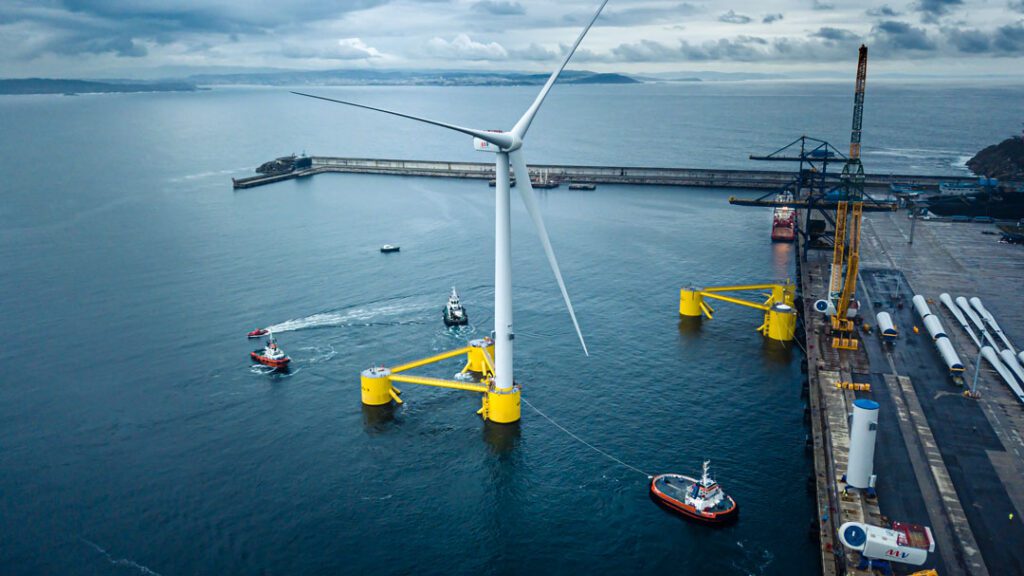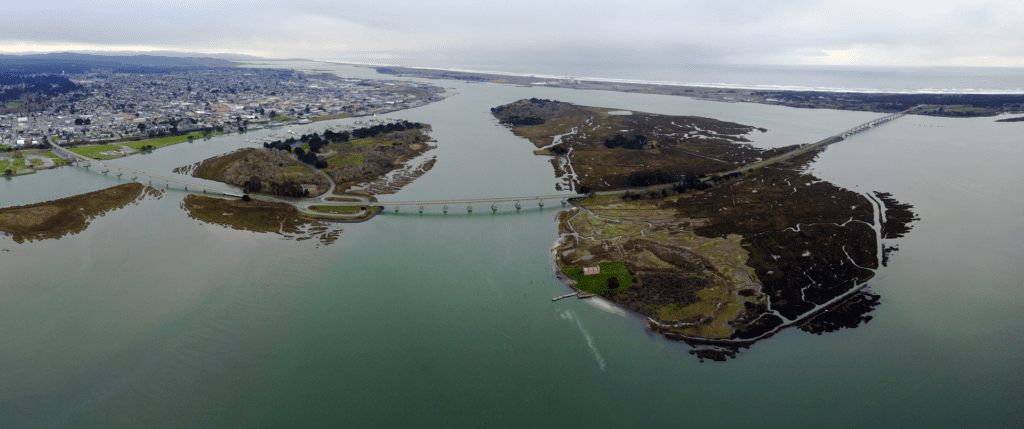Photo caption: The Bureau of Ocean Energy Management has designed an area off the coast of Humboldt Bay, seen here, as the Humboldt Wind Energy Area. The agency formally announced the designation in July, 2021, and is currently conducting a required environmental review of the area.
A new initiative, the Redwood Region Climate and Community Resilience Hub (“CORE Hub”), has launched from the Humboldt Area Foundation/Wild Rivers Community Foundation to help improve local resilience across built and natural systems. By deepening regional cooperation the CORE Hub is poised to develop equitable solutions to address growing climate emergencies.
The CORE Hub formed to help bring new resources to this region to reduce the many impacts of the climate emergency, and lower the emissions that cause climate change at the same time. An overall goal of the CORE Hub is to investigate how the Redwood Region can become the first proven carbon-sequestering rural area in the U.S. by 2030, while increasing equitable outcomes as progress is made. This 8-year initiative will align emission reductions across tribal and local governments’ activities, public and private land and resource use, built and natural systems, and other sectors.
By prioritizing communities that are under-resourced to more fully participate in solutions and decisions, the CORE Hub hopes to accelerate broad resilience across the Redwood Region, including transitions to clean energy and transportation.
An immediate CORE Hub project is a series of briefings on offshore wind (OSW) energy development, prioritizing under-represented, under-resourced communities with supports to participate. This follows a recent announcement from the U.S. Department of Interior Bureau of Ocean Energy Management (BOEM) of the process to license offshore wind production on the Pacific Coast. The CORE Hub will devote funding, coordination, research, and other community participation resources to help investigate offshore wind energy development in the region.

This project has received the support of U.S. Congressman Jared Huffman, who believes the hub is a “powerful example of the community’s desire to move away from fossil fuels — and I’m looking forward to it shaping this development process.”
The region is home to many Native American sovereign tribal nations and indigenous cultures, and the CORE Hub specifically invests in tribal expertise, to increase partnerships with tribes in climate and community resilience. The CORE Hub has begun dialogues with the region’s Native American Tribes and communities to seek their direct input, sovereign decision-making, and increased collaboration in offshore wind energy and overall climate resilience.
“The Biden Administration’s efforts to pursue offshore wind energy development is a tremendous opportunity for the North Coast — and can only be achieved with frequent and robust community engagement,” Huffman said.
Mike Wilson, Humboldt County Supervisor for the Third District, and CORE Hub advisory council member views the CORE Hub work as essential to the resilience improvements the region needs to undertake. “Our need is to collectively increase our understanding of the situation we are in with respect to climate change, the emergencies we are facing now, and the impacts to come, and work together on what we can do about it,” Wilson said. “We need resources to dedicate time to talk with each other with access to information that makes that talk – and the decisions that come out of it – well informed and more productive.”
CORE Hub co-founder Bryna Lipper, and CEO of the Humboldt Area Foundation, said the formation and mission of the CORE Hub fits perfectly into HAF’s decades-long legacy of intensive community and social development initiatives in the region. “These investments spur collaboration and local leadership, and promote the extraordinary innovation of our region,” Lipper said. “The CORE Hub initiative continues this legacy and is a deep commitment toward HAF’s new goals of Healthy Ecosystems and Environment, Racial Equity and A Just Economy.”
The CORE Hub helps locate and deploy resources for capacity and technical assistance for tribal and local governments, community-based and non-profit organizations, and others to help accelerate implementation and collaboration across the region’s portfolio of climate and community resilience initiatives. The CORE Hub also facilitates access to trusted experts, data, and research. The technical analysis for the 2030 carbon negative goal will include equity metrics, carbon lifecycles, and research of opportunities for additional sequestration of carbon in land management, in building materials, and by other means. Where applicable, it will draw from existing regional and local planning efforts and climate goals. From there, the effort will create a replicable recipe for rural areas to assess their regional carbon sequestration profile, with methods to prove climate goals and make decisions about how to achieve them.
“The Biden Administration’s efforts to pursue offshore wind energy development is a tremendous opportunity for the North Coast — and can only be achieved with frequent and robust community engagement.” – Rep. Jared Huffman, Calif.
“Engagement efforts include funding for convenings, workshops, and the sharing of knowledge, ideas and goals,” said CORE Hub advisory council member Arne Jacobson, who is also director of the Schatz Energy Research Center and a professor of Environmental Resources Engineering at Humboldt State University. “Over the coming decade, our region and the world need to make a rapid transition to an energy system that is clean, resilient and more equitable,” Jacobson said. “To navigate this transition successfully here, we will need to engage in inclusive and informed dialogue across the region’s multiple communities.”
Other developments are underway in the region, including Humboldt State University’s proposed transition to become California’s third polytechnic university which expands research and educational opportunities and new housing, a large-capacity broadband cable connecting the North Coast to Asia and other areas of the U.S., with corresponding implications for economic development, and related businesses such as data centers, and Humboldt Bay port revitalization, which could include becoming a West Coast hub for offshore wind, among many others. All these have climate and community resilience intersections and emissions profiles.
These new developments take place in one of the world’s most significant ecosystems. For example, the region’s ancient old growth and second growth redwood forests are estimated to absorb more than 600 million metric tons of carbon, or the capacity to sequester nearly 10 percent of the United States’ carbon emissions. However, these forests — and surrounding communities — are now in jeopardy because of heat gain, wildfires and other climate-amplified threats.
At the same time, the region is managing the fastest rate of sea level rise in California, recorded at three times higher than the global rate (due to land subsidence), with associated groundwater inundation. It also experiences high earthquake and tsunami risk, and tenuous connections to both electrical and natural gas grids.
Central to managing the climate crisis while strengthening the economy and infrastructure is supporting well-informed community collaboration that guides projects and policies at their earliest formative stages and throughout their life cycles. “Addressing the climate crisis is a major technological challenge, but we also have to develop and implement a range of powerful community, economic, and social systems and solutions if we are to be successful in advancing this effort with the urgency required,” said Matthew Marshall, CORE Hub Advisory Council member, and Executive Director of the Redwood Coast Energy Authority. “The CORE Hub is just the initiative needed to engage our entire community in a broad and meaningful way to catalyze and accelerate our transition to an equitable, prosperous, and sustainable clean energy-based future.”

This region has launched other sustainability innovations, including tribal cultural and prescribed fire to reduce wildfire risk, solar energy, electric and hydrogen transportation, salmon stronghold watersheds, long range water planning, forest carbon sequestration projects, climate action planning, sea level rise analysis, early and ongoing OSW research, and robust community engagement. “Significant efforts to mitigate climate and regional risks, make our infrastructure more resilient, and transition to be emission-free or carbon-absorbing are already underway,” said Jana Ganion, CORE Hub advisory council member and Sustainability and Government Affairs Director for the Blue Lake Rancheria Tribe. “The CORE Hub was formed to help further de-silo and align these efforts, include more under-represented communities in the process, and accelerate progress by working together.” Ganion is serving as the launch lead of the initiative, bringing policy and partnerships experience in energy and climate resilience sectors to help achieve CORE Hub objectives.
For more information, please visit redwoodcorehub.org or contact info@redwoodcorehub.org.

